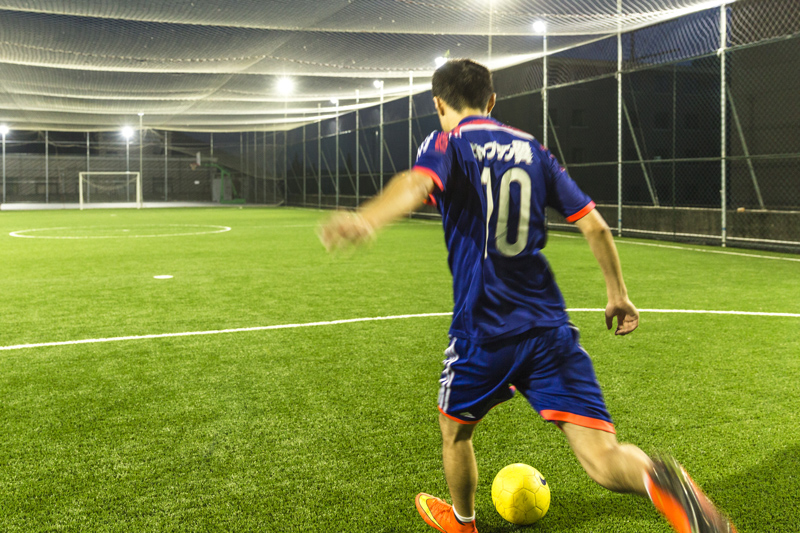2025 Ultimate Guide to How to Choose the Right Football Boots for Your Game
- 11/19/2025
In football, every movement starts from your feet. A well-selected pair of football boots doesn’t just boost performance—it also improves comfort and reduces injury risks.
Many players focus on brand, color, or endorsements, but the most important factors are stud type, sole design, material, and fit. This guide will walk you through how to choose the right football boots for your playing style, field surface, and foot shape.
In this article:
- 1. Match Your Boots to the Pitch: Sole Types for Every Surface
- 2. Stud Savvy: A Quick Guide to Configurations
- 3. Boot Material: Speed, Touch, and Comfort
- 4. Foot Shape and Fit
- 5. Additional Features for Performance
- 6. Tailoring Your Choice to Your Style
- 7. Top Football Boot Picks for 2025
- 8. Football Boot Care Tips: Keep Your Kicks Game-Ready
- 9. Conclusion: Step Up Your Game
1. Match Your Boots to the Pitch: Sole Types for Every Surface
Football boots are designed for specific surfaces to ensure optimal traction and performance. The type of field you play on greatly influences your boot choice.
SG (Soft Ground): Born for wet, muddy natural grass. These feature longer, fewer metal studs (think 4-6 per boot) for deep penetration and killer traction. Pros love them for pro leagues where pitches get a pre-game soak, but skip them on hard ground—they’re ankle-twist magnets.
FG (Firm Ground): The go-to for dry, compact natural grass. Shorter, denser rubber or plastic studs (10-15+) in conical, bladed, or hybrid shapes balance grip and release, letting you pivot without getting stuck. It’s the pros’ favorite for 70% of outdoor matches.
AG (Artificial Grass): Designed for 3G artificial grass. Shorter, more numerous studs—usually conical and often hollowed—spread pressure evenly, boost stability, and reduce stress on joints. Ideal for quick changes of direction without digging too deep into the turf.
TF (Turf): Best for older or harder artificial turf with short fibers. The outsole uses densely spaced small rubber nubs for steady, all-direction grip and even pressure distribution. Great for training and casual play, but not ideal for intense tackles—sudden twists can still catch you out.
IC/IN (Indoor): Flat rubber soles with groovy patterns for gym floors or indoor arenas. No studs means no slips on wood, just pure speed and control.
A Quick Overview of Football Boot Sole Types
| Boot Type | Stud / Sole Type | Stud Configuration | Recommended Surface |
| SG | Metal studs | 6 studs (4 forefoot, 2 heel) | Soft, muddy natural grass |
| FG | Molded rubber / TPU studs | 10–15+ conical, bladed, or hybrid studs | Firm, dry natural grass |
| AG | Shorter, more numerous hollow or conical studs | Dense layout for even pressure distribution | 3G artificial grass |
| TF | Densely spaced small rubber nubs | Low-profile, uniform grip | Hard / older artificial turf with short fibers |
| IC/IN | Flat non-marking rubber sole | Grooved traction pattern, no studs | Indoor courts/gym floors |

2. Stud Savvy: A Quick Guide to Configurations
Studs aren’t one-size-fits-all—they’re your traction toolkit. Conical for multi-directional bursts, bladed for straight-line speed, hybrids for the best of both. In 2025, expect more eco-rubber options that last longer without trashing the planet.
Quick visual: Imagine cones like ice cream scoops for agility vs. blades like skis for power.
3. Boot Material: Speed, Touch, and Comfort
Football boots are made from natural leather or synthetic materials.
Each has trade-offs:
| Material | Touch/Feel | Weight | Breathability | Notes |
| Kangaroo leather (K-leather) | Soft, flexible | Lightweight | High | Premium choice for comfort and control |
| Cowhide leather | Flexible, durable | Slightly heavier | Medium | Good balance of durability and feel |
| PU synthetic leather | Firm, supportive | Medium | Low | Budget-friendly option |
| Microfiber synthetic | Lightweight | Very light | Medium | Great for speed-focused players |
Want to outrun defenders? Focus on boots under 200g with aero uppers. Natural kangaroo leather is the gold standard—supple, breathable, and molds like a glove—but it’s pricey and rare.
Enter synthetics: Affordable PU for everyday grinders, or premium microfiber (like Nike’s Flyknit) for featherweight feels without the weight penalty.
4. Foot Shape and Fit
Selecting the right size and fit is critical for comfort and injury prevention.
Foot shape varies among players:
| Foot Type | Features | Recommended Boot Style |
| Egyptian foot | Big toe longest | Rounded toe, slightly wider boots |
| Greek foot | Second toe longest | Longer, narrower boots are possible |
| Square foot | Front toes are almost equal | Wider toe box for toe comfort |
How to Measure Your Foot For Proper Sizing
- Stand with your heel against a wall on a piece of paper.
- Mark your longest toe and measure the length.
- Leave 5–7 mm of space in the toe box for comfort.
- Measure forefoot width if possible—choose a wide or narrow fit accordingly.
Ankle Support:
- High-top boots offer extra support, especially on artificial turf with rubber infill
- Low-top boots are lighter and easier to wear, but provide less ankle protection
5. Additional Features for Performance
- Concealed laces: Minimise interference with ball contact
- Friction strips/textured uppers: Improve dribbling and ball control
- Lightweight design: Enhances speed without sacrificing stability
Choosing boots with the right combination of features can improve both your technical performance and comfort during long matches.
6. Tailoring Your Choice to Your Style
Every player has unique needs. Consider:
Physique: Heavier or more powerful players may benefit from slightly stiffer soles for stability and support.
Position / Role:
- Wingers & forwards: lightweight uppers for speed and quick acceleration
- Midfielders: balanced boots with good touch and durability
- Defenders: firmer studs and more structure for stability in tackles
- Goalkeepers: enhanced grip and quick directional traction
Playing Style: Speed-focused players may favor microfiber synthetics, while control-focused players may lean toward leather for better feel.
Choosing boots that match your position, style, and body type ensures better performance, comfort, and injury prevention.

7. Top Football Boot Picks for 2025
After understanding how to choose, here are some boot picks across different needs:
Best Overall: Adidas F50 Elite Messi – Ultra-light (≈185g), laceless for pure speed. Pros: Explosive feel. Cons: Narrow fit—size up if wide-footed.
Best for Control: Nike Phantom GX 2 Elite – Gripknit everywhere. Pros: Ball-hugging. Cons: Break-in needed.
Best Budget: Kipsta CLR Elite – Lightweight synthetic rivaling elites. Pros: Value king. Cons: Less premium touch.
Best Leather: Adidas Copa Pure 3 Elite – Supple k-leather for touch pros. Pros: Molds perfectly. Cons: Water-vulnerable.
Best for Wide Feet: New Balance Furon V8 Pro – Roomy toe box. Pros: Inclusive. Cons: Heavier.
Best for Artificial Turf: Nike Phantom GX 2 Elite AG – Dense studs for grip without drag.
8. Football Boot Care Tips: Keep Your Kicks Game-Ready
Post-Game Clean
- Let mud dry naturally, then brush off dirt with a soft brush (no metal!).
- Wipe the upper and inside with a slightly damp cloth and mild soap to remove sweat and grime.
- Rinse studs and sole crevices gently—avoid soaking or high-pressure water.
Drying & Storage
- Never use heat, hairdryers, or direct sunlight—high temperatures can cause glue failure, hardening, and cracks.
- Air-dry in a ventilated area, and stuff the shoes with paper to absorb moisture.
- For long-term storage, keep boots in a cool, dry spot away from sunlight, and use shoe trees to maintain their shape.
Leather Care (For Natural or Kangaroo Leather Boots)
- After the boots are fully dry, apply a leather conditioner regularly.
- This keeps leather soft, prevents cracking, and extends the life of your boots.
Deep Cleaning
- Every 10–15 games or when dirt is stubborn, use a professional boot cleaning kit according to instructions.
- Never put boots in the washing machine—mechanical agitation can seriously damage the upper, sole, and glued areas.
When to Replace Your Boots
- Football boots are consumables. Typically, after 6–12 months or 400–600 hours of play, performance may decline.
- Keep an eye on stud wear (affects traction), upper aging (hardening or cracks), and sole torsion resistance (too soft or easily deformed). These are the key indicators it’s time for a new pair.
9. Conclusion: Step Up Your Game
From the pitch under your feet to the studs on your boots, every detail matters. The right football boots—matched to your surface, style, and foot shape—can make every sprint sharper, every cut crisper, and every touch more controlled.
Take the time to understand studs, materials, and fit, choose boots that complement your position and playing style, and maintain them well. Small decisions off the field lead to big advantages on it.
If artificial grass is your home turf, check out our in-depth guide on Choosing the Best Soccer Turf Shoes for Artificial Grass Pitches.




